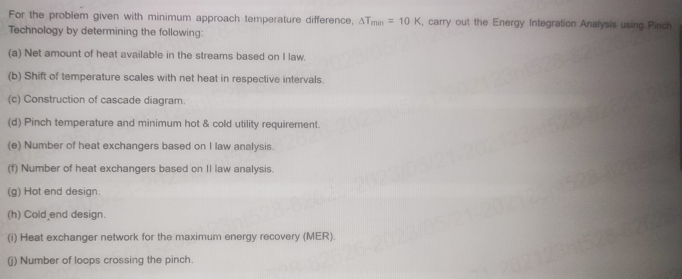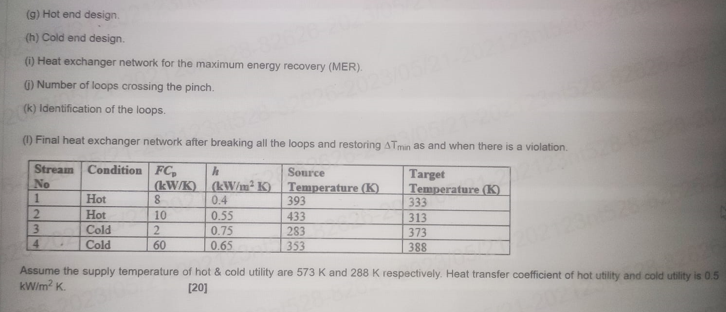Home /
Expert Answers /
Chemical Engineering /
for-the-problem-given-with-minimum-approach-temperature-difference-tmin-10k-carry-out-th-pa221
(Solved): For the problem given with minimum approach temperature difference, Tmin=10K, carry out th ...


For the problem given with minimum approach temperature difference, , carry out the Energy Integration Analysis uting Pinch Technology by determining the following: (a) Net amount of heat available in the streams based on I law. (b) Shift of temperature scales with net heat in respective intervals. (c) Construction of cascade diagram. (d) Pinch temperature and minimum hot \& cold utility requirement. (e) Number of heat exchangers based on I law analysis. (f) Number of heat exchangers based on II law analysis. (g) Hot end design. (h) Cold end design. (i) Heat exchanger network for the maximum energy recovery (MER). (j) Number of loops crossing the pinch.
(g) Hot end design. (h) Cold end design. (i) Heat exchanger network for the maximum energy recovery (MER). (i) Number of loops crossing the pinch. (k) Identification of the loops. (I) Final heat exchanger network after breaking all the loops and restoring as and when there is a violation. Assume the supply temperature of hot \& cold utility are and respectively. Heat transfer coefficient of hot utility and cold utility is 0.5 . [20]
Expert Answer
Problem-1:(a)To determine the net amount of heat available in the streams based on the first law of thermodynamics, you need to calculate the heat transfer for each stream. This can be done by considering the heat entering or leaving each stream. The net amount of heat available in the streams can be determined based on the first law of thermodynamics, which states that the heat transfer into a system equals the heat transfer out of the system. By calculating the heat transfer for each stream, you can determine the net heat available. This involves considering the heat entering or leaving each stream through processes such as heating, cooling, condensing, or evaporating. (b) The shift of temperature scales with net heat in respective intervals refers to adjusting the temperature ranges of the streams to align with the pinch temperature. The pinch temperature is the temperature at which the minimum temperature difference occurs in the system, indicating the point of closest approach between the hot and cold streams. By shifting the temperature scales, the temperature intervals can be rearranged such that the hot and cold streams match at the pinch point, facilitating efficient heat transfer and maximizing energy recovery.